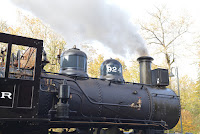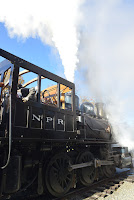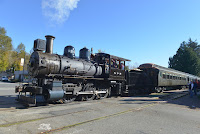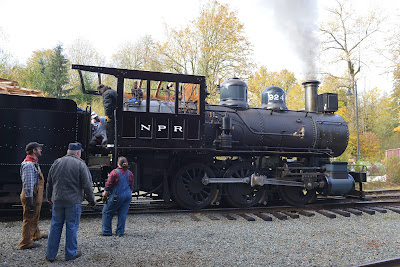The logging operation was an unfortunate necessity in protecting the Museum's collections. However, there is a silver lining: the felled trees are being cut up to use as fuel in the 924, or at least after the wood seasons in six months or so.
Tuesday, December 22, 2020
Thinning the forest
Friday, December 4, 2020
Trains are operating!
Beware of logging trucks! The Snoqualmie Valley continues to host a variety of silviculture businesses, including active logging operations. It is quite common to see fully loaded trucks rambling through town and across the tracks, generally with a high degree of safety.
Unfortunately, on Friday, December 4 one such trailer failed to negotiate the turn from Railroad Avenue on the Snoqualmie Parkway. The resulting carnage seriously injured a motorist, destroyed a car, and took out the center median crossing signals for the Snoqualmie Parkway.
The crossing signal mast and signal will be down for the count. Siemens Rail Automation will be shipping a replacement assembly in a few weeks, and until then a railroad flagman will be in position whenever trains cross the Snoqualmie Parkway. So the Yuletide Express will operate as scheduled for the next few weeks, and there will be one more person on hand to waive at Santa as he rolls on by!
Saturday, November 28, 2020
Yuletide Express
The Covid-19 pandemic is continuing its impact on Washington State, and public events remain under suspension. Unfortunately, this means the annual Santa Train - an event that has run every year since 1969 - has been canceled. The Museum is instead offering a holiday-themed train excursion called Yuletide Express. The Yuletide Express offers a safe, fun, and uplifting experience for families. Participants enjoy a 25 minute train excursion to Snoqualmie Falls. Santa is riding the train and presenting boys and girls with a small gift, and as participants detrain they receive two cookies from the Pacific Cookie Company. Life-sized photographic portraits of Santa are positioned at the Snoqualmie Depot to provide for a safe photo opportunity with Santa.
 Yuletide Express is a shorter, less intimate experience than Santa Train, but it complies with all the applicable guidelines for railroads from the Centers for Disease Control. In keeping with these guidelines, masks are mandatory and the requirement is enforced for everyone five years of age and older. The train well ventilated with windows or doors open throughout.
Yuletide Express is a shorter, less intimate experience than Santa Train, but it complies with all the applicable guidelines for railroads from the Centers for Disease Control. In keeping with these guidelines, masks are mandatory and the requirement is enforced for everyone five years of age and older. The train well ventilated with windows or doors open throughout.
The Yuletide Express is operating weekends from Snoqualmie through December 19. Tickets at $24 and are available at shop.TrainMuseum.org
Wednesday, November 4, 2020
924 on the point
History - Locomotive 924 was a product of the Rogers Locomotive and Machine Works, and is a light switcher with an 0-6-0 wheel arrangement. It was built in 1899 for the St Paul and Duluth in Minnesota, but by 1901 it was under ownership of the Northern Pacific Railway and was reassigned to the Puget Sound region. It served in Western Washington until 1923 and went on to serve the Inland Empire Paper Company near Spokane.
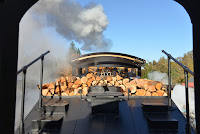 Selecting a fuel - The 924 was built to burn coal, a fuel that transformed the world in an industrial revolution. Coal is not readily available in Western Washington, and it has some negative environmental implications. So the Museum has committed to burning wood products instead of coal. For the time being, 924 is burning Douglas fir firewood, and lumber cutoffs from the Conservation and Restoration Workshop.
Selecting a fuel - The 924 was built to burn coal, a fuel that transformed the world in an industrial revolution. Coal is not readily available in Western Washington, and it has some negative environmental implications. So the Museum has committed to burning wood products instead of coal. For the time being, 924 is burning Douglas fir firewood, and lumber cutoffs from the Conservation and Restoration Workshop.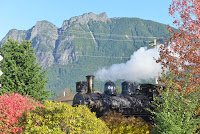 Performing the work - Much of the effort to rehabilitate a steam locomotive could be characterized as loosely directed labor accentuated with highly skilled machining. The total effort may approach 20,000 hours, but some aspects of the work have entailed a significant learning curve. And certainly it would not have been possible to undertake the work without highly skilled individuals including Jon B., Gerry P., Steven B., Josh K., Gary J., Brian W., Mike D., Lyle E. and others. Together, they have conspired to overcome the secrets of a largely forgotten manufacturing process completed more than 121 years ago.
Performing the work - Much of the effort to rehabilitate a steam locomotive could be characterized as loosely directed labor accentuated with highly skilled machining. The total effort may approach 20,000 hours, but some aspects of the work have entailed a significant learning curve. And certainly it would not have been possible to undertake the work without highly skilled individuals including Jon B., Gerry P., Steven B., Josh K., Gary J., Brian W., Mike D., Lyle E. and others. Together, they have conspired to overcome the secrets of a largely forgotten manufacturing process completed more than 121 years ago.Thursday, October 8, 2020
All Aboard! Train Excursions Resume
Take A Ride
Seasonal Train Rides
This season, look for holiday themed rides - Halloween Excursion and the Yuletide Express. Although past favorites (Halloween Storytelling and Santa Trains) are not available this year, the holiday spirit can't be dampened aboard the historic train. So come join the fun! Find out more and reserve your tickets for all of the 2020 train rides today. We look forward to seeing you and can't wait to greet you with a welcoming shout of "All Aboard!"Thanks for making it all possible
Wednesday, October 7, 2020
Bellingham Railway Museum
The Bellingham Railway Museum was established in 2003 and located in historic downtown Bellingham. It was notable for its awesome model railway exhibits, and was popular with young families. Yet despite significant local support, it could not survive the closure forced by the Covid-19 crisis. In June, its Board of Trustees announced that the temporary closure would be permanent. In Washington State, non-profits are generally expected to designate a succession plan in the event of its demise. During the dissolution of a nonprofit, the Washington State Attorney General has the final approval of the distribution of a organization's assets. The Attorney General is interested primarily in seeing that the assets remain with an organization of similar purpose.
The Northwest Railway Museum was listed as the Bellingham Railway Museum collection's successor, and was contacted early in the summer about the dissolution. The Bellingham group was located in rented space so the Museum worked quickly to inventory, pack and move the collection to Snoqualmie. Volunteers and staff spent countless hours in Bellingham preparing for the move, packing more than 400 file record boxes.
The effort was led by Cristy L., the Museum's Registrar. A museum registrar is responsible for implementing policies and procedures pertaining to collection care. This includes maintaining a collection inventory, knowing where everything in a collection is located, and protecting every aspect of its well-being including environment and security.
The demise of any museum is a community tragedy, and a loss to all involved. Yet the Northwest Railway Museum is trying to make the best of it, and is immediately incorporating the best aspects of the Bellingham collection into exhibits in the Train Shed. Initially, this includes the Lionel train set, a dining car china collection, several lanterns and signal lamps, and a series of posters.
The Museum extends condolences to the Volunteers, Trustees and Staff of the Bellingham Railway Museum and to the Bellingham community for their loss, and gratitude to former Bellingham Railway Museum Executive Director Shelissa G. for her invaluable assistance in helping with the transition.
The Northwest Railway Museum gratefully acknowledges King County 4Culture and the Cares Act Reopen grant awarded in part to support the processing and move of the Bellingham Railway Museum collection to Snoqualmie.
Thursday, October 1, 2020
Critical Times Need Critical Support
Notably, The Museum's publication, The Sounder, was redesigned in an effort led by Lee Ater of LOT22. The changes bring the newsletter into line with branding standards, easier to produce and make it more visually interesting.
Meanwhile, with the expectations for reopening the Museum came an opportunity to upgrade exhibits. This resulted in more interpretive content, and transformed the hall into a more visually-interesting experience, both of which are vital to attracting and retaining an audience.
Sadly, many pandemic-related orders are affecting the Museum in truly negative ways. The continuing prohibition on events is particularly damaging because it devastates both audience and income. And even if events were permitted in King County, they would be limited to just 50 people. Unfortunately, none of the Museum’s events are economically viable when serving smaller groups.
The
Museum is unable to host Halloween or Santa Train
this
year. However, we are improvising, and hope you will attend our alternative Safe Start activities!
Beginning
October 3, the Museum will operate regular
train ride excursions, using social distancing practices, most weekends through the end of the year.
At Halloween and during the Christmas season,
trains
will operate with appropriate holiday themes such as the Yuletide Express, but
guests
will remain on board for the duration of
their
visit. We know this may not be to everyone’s liking,
but
it does appear to be the Museum’s best practical
alternative
that keeps staff, volunteers and visitors safe,
and
complies with the law.
Your Support is Critical
We wish to thank you for your continued support during these uncertain times. The Northwest Railway Museum is dynamic and successful in part because of people just like you. Now, during the Covid-19 crisis, we need your support more than ever. Please consider helping to sustain the Museum in any of the following ways:
Visit TrainMuseum.org to find out how you can help.
Not everything about 2020 has been negative. The happiest news of the year remains the success of steam locomotive 924. Despite challenges, the 924 has successfully operated under its own power this year. Like the chapel car 5 project before it, the 924 work generated more questions than expected, but the skillful dedication of museum volunteers and staff have allowed work to continue. We hope you will be able to join us for the first run this fall—check TrainMuseum.org for updates.
Thursday, September 17, 2020
Interpreting Railways' Impact
The Northwest Railway Museum began development of the Railway History Campus in 2006, and continues its growth. Staff developed interpretive themes for the focus of exhibits. Beginning with the original interpretive themes identified in the 2010-2012 Train Shed Exhibit Hall exhibit planning, staff began expanding original interpretive themes to create a cohesive plan for interpretation across the Museum’s sites. Exhibit topics were selected based on workshop participation by the Executive Director, Deputy Director, and Exhibits Committee during that period. This featured a multi-phase exhibit plan for the Train Shed Exhibit Hall which included an exhibit sharing how the development of the transcontinental railways fueled western expansion; an exhibit on how railways then impacted the Pacific Northwest; interpretive panels on each of the historic artifacts on display; and exhibits focusing on how the railway impacted diverse groups of people. It connected these themes to exhibits at the Snoqualmie Depot; creating an exhibit about the first railway into the Snoqualmie Valley, and connecting that exhibit to one on how the Snoqualmie Depot impacted Snoqualmie. Between 2010-2019 the Museum
 completed the first three
phases and began working on the fourth phase with planned exhibits on
Stewardess Nurses, Japanese-American Railway Workers, and Railway Workers of
WWII (the Faces of the Railway
exhibit).
completed the first three
phases and began working on the fourth phase with planned exhibits on
Stewardess Nurses, Japanese-American Railway Workers, and Railway Workers of
WWII (the Faces of the Railway
exhibit).
The Museum’s mission
clearly describes two important themes: 1) the story of experiencing the
excitement of a working railway; interpreting ways that visitors can be
involved in the ongoing heritage and operations of trains. And, 2) the story of how railroads influenced
the development and settlement of Washington State and adjacent areas;
interpreting how railways changed everything in the Pacific Northwest.
As the Museum has expanded exhibit offerings within the Train Shed Exhibit Hall, the plans for a fourth building, the Roundhouse Gallery, prompted the need to review and elaborate the Interpretive Plan just as the former plan neared completion and was due for review. This has coincided with the Covid-19 pandemic causing new social behavioral changes and social gathering size restrictions, which have necessitated new ways of envisioning traditional operating models.
Consequently, this spring the suspension of programming caused by the Covid-19 pandemic redirected efforts and allowed the Interpretive Plan and exhibits to be updated with additional content in the Train Shed Exhibit Hall. Now, as visitors experience the Train Shed, they travel a directional route exploring how the arrival of the transcontinental railway changed settlement patterns, foodways, trade networks, leisure travel and industry. Additionally, they explore aspects of what people working for the railway have experienced with new exhibits on railway workers. Additional exhibits will be arriving later this fall and winter expanding upon these stories with the installation of Asa Whitney’s Dream, an exhibit on railway car lighting, and an exhibit on the Japanese and Japanese-American logging railway workers of the Snoqualmie Falls Lumber Co. Tickets to visit the Train Shed Exhibit Hall are currently available at Shop.TrainMuseu
m.org.
Friday, September 4, 2020
Train Shed reopens September 11
 The Northwest Railway Museum is pleased to announce the planned reopening of the Train Shed Exhibit Hall. The Train Shed will reopen on Friday, September 11th at 11
am, and is located in Snoqualmie at 9320 Stone Quarry Road. It includes many of the Museum’s most
significant artifacts including chapel car 5 Messenger of Peace, and a variety
of exhibits about how the railway changed everything. The hall incorporates
more than 24,000 square feet, and has not been able to reopen this year until
now due to the pandemic.
The Northwest Railway Museum is pleased to announce the planned reopening of the Train Shed Exhibit Hall. The Train Shed will reopen on Friday, September 11th at 11
am, and is located in Snoqualmie at 9320 Stone Quarry Road. It includes many of the Museum’s most
significant artifacts including chapel car 5 Messenger of Peace, and a variety
of exhibits about how the railway changed everything. The hall incorporates
more than 24,000 square feet, and has not been able to reopen this year until
now due to the pandemic.  Beginning September 11, the Train Shed will be open every week until the Christmas season, Fridays through Sundays from 11 am - 4 pm, and on Wednesdays from 1 pm- 4 pm.
Tickets are available online at shop.TrainMuseum.org and must be purchased in
advance; adults are $10 and children are $5.
Beginning September 11, the Train Shed will be open every week until the Christmas season, Fridays through Sundays from 11 am - 4 pm, and on Wednesdays from 1 pm- 4 pm.
Tickets are available online at shop.TrainMuseum.org and must be purchased in
advance; adults are $10 and children are $5.Monday, August 31, 2020
More on the 924 debut
The Museum's Northern Pacific Railway steam locomotive 924 made a brief public appearance while testing earlier this month. The 1899-built Rogers 0-6-0 has been undergoing rehabilitation and restoration for five years in the Museum's Conservation and Restoration Workshop. An earlier blog post shared some highlights of the two hour session, but today this blog features a few moving pictures of this milestone event. This video shows some rare views from inside the cab, which are particularly clear because the roof of the cab had not yet been added. The new boiler jacketing is also visible, which was applied from the outset to protect the safety of the cab crew.
This author is also pleased to share news that the 924 will make another public appearance this fall - all aboard!
Saturday, August 22, 2020
Snoqualmie Depot Exhibits Reopen
Since early March the Northwest Railway Museum and most other museums in the state have been closed by order of the Governor of Washington State and King County health officials to help reduce the spread of Covid-19. In June, the Museum reopened its bookstore but kept all exhibit and gallery spaces closed to help reduce the amount of people in contact with each other. On August 20th, the Governor approved a new plan that allows museums to reopen in Phase 2 following new guidelines. The Northwest Railway Museum is now excited to begin the process of reopening!
The Museum remains open at 25% capacity, so only 6 people may visit each room at a time but visitors may again enjoy the exhibits in the Freight Room and Waiting Room. There is now a new directional visit to each space. As you visit the Freight Room tour the space beginning on the left. To visit the Waiting Room, enter the bookstore via a left loop and then tour the Waiting Room on a right loop, returning through the bookstore to finish the loop out. All visitors over 2 years of age are asked to wear masks and masks are required for all visitors over the age of 5 years old as per the Governor's reopening guidelines.
 Following the reopening guidelines, all touchable interactive exhibits like the Train Tables have been temporarily removed. Though the Museum hopes to bring back these interactive exhibits when allowed, their removal creates a more open and less cluttered experience. You may notice new signage like this Please Do Not Touch Historic Artifact sign as part of the new guidelines.
Following the reopening guidelines, all touchable interactive exhibits like the Train Tables have been temporarily removed. Though the Museum hopes to bring back these interactive exhibits when allowed, their removal creates a more open and less cluttered experience. You may notice new signage like this Please Do Not Touch Historic Artifact sign as part of the new guidelines.The Museum's staff and volunteers are working diligently to reopen the other sites as quickly as possible. Stay tuned for further announcements as they become available! The Train Shed Exhibit Building is being revamped with a new directional experience and additional exhibits. The Museum staff and volunteers look forward to sharing this space with you as soon as it is ready.
Wednesday, August 19, 2020
Riding The Suffrage Special
 |
| June 27, 1909 Seattle Times article. |
To commemorate the role that the Suffrage Special Trains played, the Museum put together a video based on the rear platform speeches given at stops by Suffrage leaders. The presentation details the role of Suffrage leader Anna Howard Shaw and uses a compilation of quotes from her speeches and letters throughout the years of her work. The video is one piece of a new Suffrage Train exhibit which will debut in the Train Shed Exhibit Building when the Museum reopens.
 | |
| Anna Howard Shaw |
Anna Howard Shaw Background: Born in England in 1847, Anna moved to the United States at the age of four. At a time when women were expected to only marry and become mothers, she took a different path. At the age of 24 she became a Methodist preacher and without family support, entered Albion College and began a career lecturing on temperance (abstinence from alcoholic drink). In 1878, at the age of 31, she graduated from Boston University Divinity School but was not ordained until 1880 due to being female. She received her medical degree in 1886 from Boston University at the age of 39.
In 1888, Anna attended the first meeting of the International Council of Women. Leading suffrage advocate Susan B. Anthony encouraged her to join the National Woman Suffrage Association where Anna played a key role in persuading the American Woman Suffrage Association to merge with the National Woman Suffrage Association. She was Vice President of the National American Woman Suffrage Association under Susan B Anthony’s presidency and later became president of the Association herself.
 |
| King Street Station in Seattle, 1909 |
At the age of 62, she traveled on the 1909 Suffrage Special as it made its way across the country and throughout Washington State to attend the National American Woman Suffrage Association Convention in Seattle, which had been timed to coincide with the Alaska-Yukon–Pacific Exposition. It was believed that “the confluence of the widely publicized convention and the world's fair will help win supporters for women's right to vote.” Along the way she gave speeches from the rear platform of the train. Her work helped pass women’s suffrage in 1910 in Washington State.
In her 70s, she performed home front war work during WWI and earned a Distinguished Service Medal in 1919. At the end of the war, at the request of President Wilson and former President Taft, she lectured in the U.S. and Europe in support of world peace and the League of Nations. During one of those tours she fell ill and died in July 1919 at the age of 72, just 13 months before her life’s work culminated in the ratification of the 19th Amendment.
Tuesday, August 18, 2020
924 takes the main
In celebration of a social-distant, Snoqualmie Railroad Days lite, the Northwest Railway Museum was pleased to introduce to the community newly certified steam locomotive 924, an 1899 Roger's built 0-6-0 that served the Northern Pacific Railway in Washington until 1923, and continued in service for the Inland Empire Paper Company until donated to the Museum in 1969.
 |
| NPR 924 arrives at Snoqualmie on Aug 15, 2020 |
 |
| The open cab helped the crew tolerate temperatures in the 90s. |
Northern Pacific Railway 0-6-0 924 has been undergoing rehabilitation and restoration for more than five years, and on Saturday, August 15, 2020, it finally had an opportunity to "strut its stuff" on the main track. The operation was technically just a testing day, and was planned to check out - or prove - all the work that had been performed up until that time. The 924 was accompanied by a combine car with several observers, and diesel-electric locomotive 4024 to provide a light braking load as desired, and to allow for safe backup movements. And the day was a spectacular success: the only issues evident were already known to the 924's team.
 |
| The 924 is temporarily sporting an open cab while plumbing is continuing to be adjusted. |
How remarkable was Saturday's run? The last time the 924 propelled itself up a main track Jimmy Carter was President, Amtrak was still introducing the original Superliners, and EMD/GMD's model SD40-2 locomotive was enjoying peak production. That was in 1979 when the 924 was on loan to the Chehalis-Centralia Railroad, and the 924 steamed its way down to the Burlington Northern mainline to greet British Columbia's Royal Hudson 2860 as it passed by on a tourism promotion tour.
The day was also an opportunity to continue the training process for crew members new to steam. The 924 has been set up to burn solid fuel, and there is a little more planning required before moving the locomotive. Planning? Solid fuel takes time to ignite so the fireman has to ensure the fire is already hot and the boiler is producing more steam before the engineer cracks open the throttle. Otherwise, the locomotive will quite literally run out of steam.
 | ||
|
Monday, July 27, 2020
924 Testing
 On a blistering-hot July 27, 2020, steam locomotive 924 emerged from its track inside the Conservation and Restoration Workshop for additional testing. The 924 is an 1899-built 0-6-0 Rogers locomotive that served the Northern Pacific Railway in the Everett-Seattle-Tacoma region until 1923.
On a blistering-hot July 27, 2020, steam locomotive 924 emerged from its track inside the Conservation and Restoration Workshop for additional testing. The 924 is an 1899-built 0-6-0 Rogers locomotive that served the Northern Pacific Railway in the Everett-Seattle-Tacoma region until 1923. 
The 924 has been undergoing a complete rehabilitation, with restoration to its appearance circa 1908. Already, an investment of more than $500,000 has been made in this King County and City of Snoqualmie Landmark with support from local residents, museum volunteers, individual donors, 4Culture, Washington Heritage Capital Fund, the Emery Rail Trust, Northern Pacific Railway Historical Association, Schwab Fund, and more.
Check out the moving pictures of the 924 in action:
 The July 2020 testing was scheduled to prove the air brake system, most of which was re-plumbed with new schedule 80 piping giving the 924 a fully functional early 20th Century G-6 brake system. Meanwhile, a number of minor boiler issues including some leaking stay bolts and boiler tubes were being re-tested to see if they had been successfully sealed.
The July 2020 testing was scheduled to prove the air brake system, most of which was re-plumbed with new schedule 80 piping giving the 924 a fully functional early 20th Century G-6 brake system. Meanwhile, a number of minor boiler issues including some leaking stay bolts and boiler tubes were being re-tested to see if they had been successfully sealed. The 924 was also put through a series of operating exercises, including pushing a braking diesel to simulate a load to check for things such as the efficacy of the cylinder packing. The locomotive tender's new water tank was completely filled with water, but unfortunately did continue to experience several leaks, which will have to be sealed before the tank can be painted. So not everything is perfect, but the 924 is 121 years old. Yet aside from exceedingly high atmospheric temperatures, it was a perfect day to run a steam locomotive in the scenic Snoqualmie Valley.
The 924 was also put through a series of operating exercises, including pushing a braking diesel to simulate a load to check for things such as the efficacy of the cylinder packing. The locomotive tender's new water tank was completely filled with water, but unfortunately did continue to experience several leaks, which will have to be sealed before the tank can be painted. So not everything is perfect, but the 924 is 121 years old. Yet aside from exceedingly high atmospheric temperatures, it was a perfect day to run a steam locomotive in the scenic Snoqualmie Valley.Work on locomotive 924 is continuing and a public debut is expected later this season. In the mean time, your support helps ensure this work can continue, and is tax deductible to the extent permitted by law. Please visit the Northwest Railway Museum's online donation portal to pledge your support.










